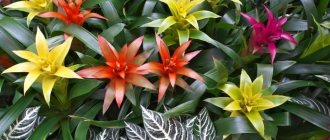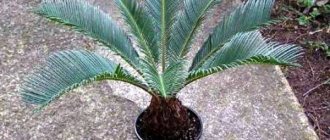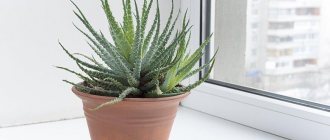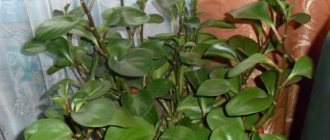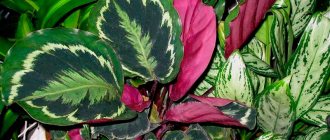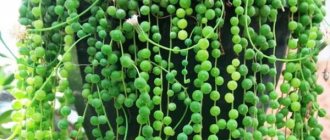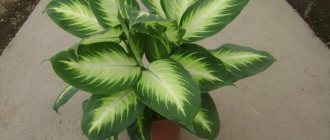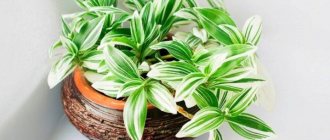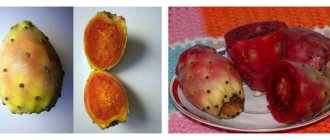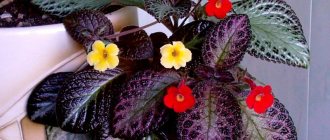Origin
The herbaceous perennial Cyperus belongs to the Sedge family, its homeland is hot Africa.
The plant is widespread along the entire coast of the Nile, growing in marshy areas. Papyrus forms dense green thickets, more than 3 m high. Papyrus was cultivated in ancient times, making baskets, rugs, and, most importantly, paper from long shoots.
As an ornamental plant that decorates the banks of reservoirs and has an original appearance (a green “fountain” of delicate foliage on a strong bare stem), dwarf papyrus is cultivated, the height of which is limited to 100 - 140 cm.
Cyperus growing from seeds
The seeds are sown finely in bowls, which are filled with a mixture consisting of peat, leaf soil and sand in a 2:2:1 ratio. The bowls are covered with glass or a bag to maintain constant soil moisture. Ventilate daily and water as needed. The temperature is maintained above 18 degrees.
Grown seedlings are planted in groups of 3 in small pots in the ground of the same composition as for seeds. Young plants are watered abundantly and protected from direct sunlight. When the plants grow up, they are planted in 9-centimeter pots. The substrate is prepared from turf, peat soil and sand, taken in a ratio of 2:1:1.
Description
For its great love for moist soil and swamps, in ancient mythology this plant received the name “gift of the rivers.” In its natural habitat it grows up to 4-5 meters, forming impenetrable thickets. Some representatives grow up to half a meter per season, and several of these plants can form a real green wall.
Cyperus has elongated stems, the top of which is crowned with a rosette of narrow whorled leaves. The peduncle is erect, the stems are flexible, so they can withstand even strong gusts of wind. The leaf blades are linear, grow and open in the form of umbrellas, in which they are distributed unevenly, which makes them look like small rays of sunlight, giving the cyperus significant volume. The color palette ranges from light shades of green to dark ones. Rarely, there are varieties of white and brown tones.
The flowers are small, milky or white-green, rather inconspicuous. Most often, flowering is observed in early summer, but some varieties can bloom continuously until mid-autumn. The pollen is very small and is easily carried by gusts of wind to nearby plants. At the end, fruits are formed - ears or brown nuts.
Its root system is of a creeping type; the roots are powerful and quite long, as a rule, located in the surface layer of soil. Some varieties of cyperus have spindle-shaped processes instead of roots, which, despite this, do not prevent them from taking the necessary nutrients and water from the soil. The characteristics of the root system largely depend on the species diversity of this crop, therefore, when purchasing a plant for the purpose of growing at home, you need to find out what soils will be comfortable for each specific variety. In indoor gardening, cyperus plants with shortened roots are usually cultivated - they are optimal for planting in a decorative pot or small flowerpot.
Sitovnik does not like brightly lit places, preferring darkened rooms and adjacent areas. It looks great near an aquarium or country pond.
If you want to fill your room with exceptional freshness, then cyperus will cope with the task assigned to it in the best possible way - its sophisticated stems with decorative leaves will sway from the slightest gust of wind, literally captivating the eye with its unusual appearance and lightness.
There are a lot of myths and beliefs associated with cyperus. It is believed that the shape of this bush resembles a waterfall, which brings the energy of life into the house. According to the teachings of Feng Shui, the flow of waves emanating from this flower allows the inhabitants of the house to maintain their strength and vigor throughout the day, help to overcome problems and overcome prolonged depression.
Cyperus stimulates activity, does not tolerate laziness and idle pastime, its energy pushes children and adults to constant movement, therefore, after communicating with the plant, you often get the feeling that you are ready to literally “move mountains.” Tsiperus should be kept at home for schoolchildren, students and people engaged in business and scientific activities. His energy allows him to cope with heavy mental and nervous stress. By the way, these legends have a very real scientific basis - cyperus emit an increased amount of oxygen, due to which the cells of the human body are provided with better nutrition. A person in a room with this flower experiences a surge of strength and vigor.
In Egypt, baskets and all kinds of mats are often woven from the stems, and the roots are even eaten - they are added to vegetable salads, nutritious infusions and meat dishes. It is also widely used in alternative medicine. A decoction of green leaves helps fight insomnia, migraines, and also normalizes metabolism and stabilizes blood pressure.
If you add honey to the decoction, the resulting drug will alleviate stomach pain.
Cyperus transplantation and soil selection
How to transplant Cyperus photo
Transplantation can be carried out at any time of the year; the plant tolerates it well without compromising growth. Florists recommend observing the seasonality of planting - in early spring and late autumn, during periods when plant growth stops. Before planting, it is necessary to ensure stable temperature and humidity to avoid stress.
Young bushes are replanted annually, changing the volume of the vessel. An adult plant is replanted only if the soil is completely depleted; cyperus does not grow in one pot all the time, so you need to monitor the condition of the soil and replace it in a timely manner.
Cyperus is suitable for a deep, but not wide vessel, the bottom of which is filled a quarter with pebbles and sand. The soil for planting is mixed with peat, sand, and dry grass to ensure good drainage, and water will bubble around the root system. Wood sawdust and shavings or dried tea leaves are poured on top for good air exchange.
- The soil can be selected ready-made for moisture-loving indoor plants, or you can mix it yourself, maintaining an acid-base environment of pH 5-8.5.
- It will be great if you add sapropel or river silt to the soil.
- The ratio of peat soil, humus, and marsh silt is 1:1:1/6.
- The ratio of clay-turf soil, leaves, peat, river sand is 2:1:1:1.
- You can add brick chips, charcoal, and crushed eggshells, sifted from dust, to the bottom of the container. Cyperus grows well on hydroponic material, but it is better to follow the proportions for soil preparation.
How to transplant Cyperus, look at the video:
Signs and superstitions
There are a lot of signs associated with Cyperus. Esotericists believe that Cyperus has a very powerful energy field. Despite the fact that he is considered an energy vampire, the flower’s vampirism is special - it feeds on negative vibes, clearing the surrounding space of negativity. The leaves, acting as a trap for “bad” signals, stand guard over the house. Maybe that’s why people who know this feature call Cyperus a “home guard.”
In addition, the plant improves the emotional background, reduces stress, has a beneficial effect on character, curing depression.
However, esotericists warn that you can only leave it in the bedroom for a very short time, and only if there is a goal to cure insomnia. It is absolutely not advisable to constantly keep it next to your sleeping place; after all, this plant is a vampire.
A powerful, beautiful plant consisting of huge (up to 2 m in length) stems, which are crowned with decoratively hanging large leaves in whorls. It is almost never used in indoor floriculture, but in gardens and around ponds it looks very beautiful. Blooms with rare single flowers.
According to Chinese teachings, cyperus protects against lies, hypocrisy, betrayal and betrayal.
Diseases and pests
This plant has good immunity and is therefore resistant to pests. But if the air in the room is too dry, spider mites may appear. Sometimes the plant can be attacked by whitefly, scale insects, and mealyworms. Problems usually appear due to improper care.
What to do if signs of the disease are noticed?
If you notice the pest in time and take the necessary measures, the flower can be saved. A soap solution used to treat the stem and leaves, as well as spraying with an Actellik solution, will help protect against pests.
general information
This plant greatly influenced the development of the entire civilization. Writing material was made from it. What can a person imagine when he hears the word “papyrus”? Egypt - hot desert sands, camel caravans, pyramids, sphinxes, pharaohs, hard-working Egyptians and many others. etc. And among all this there is an image of a clerk writing something under the dictation of his master. All this is Ancient Egypt.
The word papu, meaning "royal", is of ancient Egyptian origin. It was from this that the ancient Greek papyrus was formed, which is the name of the well-known writing material (papyrus).
The homeland of the plant is Egypt. There it was considered royal.
Papyrus (plant) brought great benefits. Pictures and writings made on such material entered the history of Egypt and became exhibits in many museums around the world.
The word “paper” also owes its origin to papyrus. In German, paper is papier, in French it is papier, and in English it is paper. Carl Linnaeus used a Latinized version of this word as the name of this plant - papyros.
The oldest known papyrus manuscripts date back to the beginning of the third millennium BC.
Papyrus (Sweet papyrus) is a perennial herbaceous plant (sedge family), mainly found in Africa. There are other names for this plant - paper reed, papyrus sedge.
Papyrus can sometimes be mistakenly called papyrus. This is a common greenhouse or decorative houseplant.
A dwarf relative of papyrus, reaching a height of one meter, is Cyperus nanus or Cyperus profiler.
Natural papyrus is a plant of enormous size (up to 5 meters in height, up to 7 cm in diameter) with almost leafless shoots. Its triangular-shaped stems grow from a tree-like thick rhizome, with brown scale-like underdeveloped leaves located at the base of each stem. At the end of the stem there is a large umbrella-shaped inflorescence, which in a young plant has the shape of a feather panicle for brushing dust from furniture.
The tuft at the end of the branch has bright green stems up to 30 centimeters long. Each of them branches into 3-5 rays of the 2nd order, equipped with drooping narrow covering leaves. At their top are green-brown ears up to 2 centimeters long. Flowering of papyrus usually occurs in late summer. The brown fruits are very similar to nuts.
Pollination of papyrus, like most sedges, occurs with the help of wind, not insects. Ripe fruits spread through the water.
The inflorescences of this amazing plant provide an excellent nesting place for birds of various species.
The geographical extent of the plant is very diverse. These are subtropical and tropical deserts, humid forests with annual temperature intervals from 20 to 30 degrees Celsius and hydrogen content in the range of 6.0-8.5 pH. Good sunlight is a favorable factor for successful flowering. Papyrus, like many tropical plants, is very sensitive to cold.
Large thickets of this plant are mainly found in wetlands, shallow lakes and along river banks in the most humid areas of Africa. Today, papyrus is becoming less and less common in the Nile Delta. In deeper waters it is the main component of huge masses of floating plants called Sudd.
This plant can be found in the Mediterranean regions (Levant and Sicily) and Madagascar.
Cyperus (papyrus) is an indoor plant, moisture-loving, similar to both a small palm tree and an umbrella. It, unlike its relatives growing in natural conditions, can feel good even in the shady part of the room, among other house flowers or in interior ponds.
On the herbaceous stem of the plant there are nodes from which narrow leaves grow, forming an umbrella.
There are only a few species of home-grown cyperus known. Umbrella grows up to one and a half meters. It has very narrow long linear leaves (24 cm long). These cyperuses are also found with leaves that have a white stripe. Panicles of yellow inflorescences appear from their axils.
The shortest representative of the family is the spreading cyperus with a stem height of up to 90 centimeters and with many leaves up to 30 cm in length. This is the most common species among home floriculture lovers.
Description of the flower Cyperus pharaoh
In the wild, the height of the plant’s stem can reach 4 m. Indoor varieties of Cyperus, thanks to periodic pruning, do not grow more than one and a half meters. The root system of the plant is highly branched and located in the upper layers of the soil.
Erect stems grow singly from the soil, without any lateral branches. At the top of the shoot there is an umbrella consisting of long and flat leaves. The base of the Cyperus stem gradually acquires a yellowish-brown tint. At the top of the flower, light green and sometimes even blue shades are noticeable.
The flowering period usually occurs in the summer. Although cyperus often bloom throughout the year. Small flowers are formed in the umbrella itself in the axils of the leaves. The flowers are yellow-green. After flowering, small seed pods are formed, containing oblong gray-brown seeds.
Why are papyri needed?
Probably, when the world saw the first papyrus, it was clear to everyone. It is a way of storing information in written form. At that time, several great civilizations already had their own written language:
- The Sumerians used clay tablets to store information. The invention, of course, is good and significant, it is difficult to overestimate it. But still, it was inconvenient to use them. First of all, they are heavy. Secondly, they are difficult to produce. Secondly, they can easily break.
- The Babylonians used clay tablets similar to Sumerian products. They invented cuneiform - a method of writing on soft clay with a special stick. Since writing was difficult, the resulting images were created from elements similar to wedges. Hence the name of the writing technology.
After the Egyptians invented papyrus, the majority of the population learned what kind of object it was. The new writing material eliminated all the problems that existed previously. The new way of storing information was truly revolutionary.
Drawings on papyrus have survived to this day.
Now you could drop papyrus and write on it at almost any time without fear of breaking it. In this sense, the revolutionary nature of the invention of writing material is comparable to how different methods of storing information for computers are changing in our time. Each time a change of medium means a change in the very fundamental principles of interaction with the material and even between people.
For example, in an era when the Internet did not yet exist in its current understanding, it was customary to exchange disks with each other on which useful information was recorded. There was an entire culture built around this phenomenon. Today it has gone away as unnecessary, but it has been replaced by new forms of communication between people.
Papyrus created approximately the same revolution; everyone who saw the new writing material knew what it was.
Beneficial features
Since ancient times, cyperus has had a huge useful purpose. Its strong stems were used in the process of weaving baskets, clothing items and, of course, making ancient paper - papyrus. The fatty root systems of some Cyperus species were used as food, so the reference to "ground almond" is sometimes appropriate.
Signs - lovers of esotericism say with one voice that culture brings extremely useful energy to life, protects the hearth, encourages new knowledge, helps overcome depression, stimulates physical well-being. An excellent air purifier and destroyer of harmful bacteria. The best place for it is the bedroom, which provides relaxation and sound sleep.
Varieties
There are about 600 species in the Cyperus genus. They are all very similar to each other. Only a few individual species are grown at home.
- Cyperus spreading. This plant is a rather lush bush, growing up to 50-60 cm in length. The top of each stem is crowned with a rosette of erect leaves in the shape of an umbrella.
- Cyperus alternate-leaved (umbelliferous). A perennial herbaceous shrub with many narrow leaves of a rich dark green color. There is a variegated subspecies with variegated foliage. Its length reaches 1.5 m. If comfortable living conditions are maintained, it can bloom throughout the year with inconspicuous yellowish flowers.
- Cyperus papyrus. This indoor variety can grow up to 1.5-2 m in height, its stems are quite dense and fleshy, its leaves are thin and form a dense crown. This is one of the most demanding Cyperus plants to care for.
- Cyperus Helfera is a low plant up to 50 cm. In natural conditions it grows on the banks of swamps. The stem is shortened, crowned with a panicle of narrow long leaves. This flower prefers wet substrates, so it is most often placed in aquariums as a houseplant.
Cyperus varieties “Pharaoh” and “Zumula” are also often grown in home floriculture.
Growing Cyperus at home
How to care for cyperus at home photo
If you need to fill the room with freshness, then the plant will cope with this task perfectly. Its thin stems with thread-like umbrellas move from any wind or draft (open window, fan, air conditioner), captivating the eye with its unique lightness and unusual appearance.
Lighting
Despite the low need for sunlight, Cyperus does not tolerate a long absence of sun, so short winter days need to be “extended” with the help of artificial lighting with fluorescent lamps. The eastern and western sides of the house are perfect when direct rays enter the room 4-6 hours a day. If all the windows are on the south side, then shade the light a little by placing the flower in the far corner away from the window. So the light will be bright, but diffused, which is important for active growth and flowering.
Air temperature
A room temperature of 22-26 degrees in the summer during the growing season is considered normal for satiety. In winter, the temperature can be reduced to 14 degrees, but not lower, so it is not recommended to leave windows open for a long time, and the flower itself is removed further from the window. In nature, a healthy adult plant tolerates 0-2 degrees. It is better to ventilate warm apartments more often to maintain the optimal temperature. An increase in the thermometer in an apartment in the summer will have an adverse effect on the entire plant.
Air humidity
Aquatic origin made the plant demanding of moisture not only in the soil, but also in the air. An excellent indicator of air humidity is considered to be 70-75%, which may not be liked by other green residents, so you need to carefully select neighbors for cyperus.
You can maintain air humidity using a room humidifier, regular spraying of the green mass of the plant, or dousing in the shower. Water douches help clean the leaves and stems of dust and “revive” the plant. Aquariums and other water containers also help maintain air humidity levels.
Watering
The plant loves a lot of water, but does not tolerate stagnation - the roots and stems begin to rot. The tropical climate with heavy rains moistens the soil, and the scorching sun manages to evaporate excess moisture. To maintain the necessary soil moisture, water the apartment every day, not allowing the soil to dry out.
The easiest way to maintain a constant level of humidity is to use root bottom watering through a tray, from where the plant will take the required amount of water.
Fertilizing with mineral and organic fertilizers
Cyperus responds gratefully to mineral fertilizer for indoor flowers, which is necessary for decorative foliage plants. Fertilizers are applied every 2-3 weeks throughout the growing season, reducing by a third in winter. Only a period of active growth can guarantee complete absorption of fertilizers; an excess is as harmful as a deficiency. Complex feeding should include nitrogen, potassium, and phosphorus minerals. Fertilizer application rules:
- follow the manufacturer's dosage; there may be simple and concentrated formulations;
- halve the dose for young bushes;
- prevent the solution from getting on the green mass, which can cause burns;
- Nitrogen fertilizers are applied first during the season, which help the formation of green mass; potassium and phosphorus are added for flowering and vegetation;
- Before adding the solution, thoroughly water the soil, otherwise there is a risk of burning the roots.
Varieties, table
There are about 600 species of Cyperus, but the most common is Cyperus alternate-leaved. It is so easy to care for that it can be found almost everywhere: in shops, offices, workshops of industrial enterprises, and, of course, on the windows of flower growers. Cyperus saturates the dry air of rooms with moisture, evaporating it from the surface of the leaves.
| Name | Description | Peculiarities |
| Cyperus papyrus | The stems grow up to 3–5 meters in height and end in a dense rosette of narrow leaf blades hanging down. | Grown in pots in humid climates. It is rare in indoor floriculture due to the difficulties of reproduction. |
| Cyperus Helfera | It has low stems up to half a meter in height and grows in water. | Used for landscaping decorative ponds and aquariums. Requires an acidity of 5–7.5 pH. |
| Cyperus umbelliferum | The stems are triangular, up to two meters high, with long 30-centimeter linear leaves, resembling a belt. | Variegata variety with a white stripe on the umbrellas was developed. |
| Cyperus alternate leaf | A relatively low species, growing up to 1.5 meters in height. The stems end in an umbrella with leaf blades 1 centimeter wide. | The most common type of cyperus in indoor floriculture, it is easily propagated by division, umbrellas and seeds. |
| Cyperus spreading | The lowest of all Cyperus, only 40–100 centimeters high. The width of the leaf blade is 1.5 cm. Many leaves are located at the base of the stems, which gives it a lush appearance. | It is not very common in potted culture, but, like all cyperus, it is unpretentious in care. |
| Cyperus zumula | A bit similar to Cyperus Helfer: the same bunch of grass blades growing straight from the ground and some palm-shaped leaves. A very spectacular flower. | It propagates well by seeds, which can be bought in the store. |
Cyperus species
Not all types and varieties of Cyperus are suitable for indoor conditions; the most commonly grown Cyperus is Regular. The plant is tall, reaching 2 meters under favorable conditions, with a triangular stem and neat umbrellas of leaves cascading down like a waterfall. The flowering is inconspicuous, mostly green flowers with a spike-shaped fruit. Grown for its beautiful leafy umbels that form an elegant crown at the top.
There are several varieties of Cyperus, which differ in the shape of the bush, place of growth, origin, and use.
- Cyperus graceful is distinguished by its reduced size, short leaves, and pale green color.
- Cyperus variegata with a white stem and light striped leaves.
- Cyperus Zumula is represented by long leaves that fall like a waterfall, sometimes exceeding the size of the stem.
- Cyperus Papyrus reaches a height of 3 m, so it is not a frequent guest for growing indoors. Although it can be found in multi-level shopping malls, art institutions and tropical greenhouses.
Rosettes of long leaves form at the tops of stems that droop downward like the flow of a stream. It gained popularity for its use as the basis for the writing of the ancient peoples of Egypt. Nowadays you can find its thickets on the banks of the Nile.
- Spreading Cyperus is the most compact of the rush plants, its height does not reach 1 m and ranges from 60-90 cm. The leaves cover the entire stem, the rosettes vary in size and number of leaves. Outwardly, the bush resembles a small palm tree.
For decorative cultivation, all of the listed species are used, taking into account the conditions for optimal growth. Cyperus grows actively near a body of water, so it will feel great next to an artificial source of water or in an aquarium.
Planting and caring for tsiperus
- Flowering: grown as an ornamental foliage plant.
- Lighting: bright diffused light, partial shade (eastern or western window sill).
- Temperature: in summer – normal for residential premises, in winter – not lower than 12 ˚C.
- Watering: frequent and plentiful.
- Humidity: very high. It is recommended to constantly spray the leaves and keep the plant on a tray with wet pebbles.
- Feeding: complex fertilizer for decorative deciduous plants: in the warm season - twice a month, in winter - once.
- Rest period: not observed.
- Replanting: as needed at any time of the year.
- Reproduction: by seeds, dividing the bush, apical cuttings and rosettes.
- Pests: spider mites, aphids.
- Diseases: does not get sick, but due to insufficient humidity it may turn yellow and lose its decorative effect.
Features of flower care at home
Cyperus - home care and reproduction
Cyperus care at home requires knowledge about the rules of cultivation. Otherwise, it will not please its owners with bright foliage, it will begin to shed it and gradually dry out.
Cyperus Helfera
Temperature
In summer, the plant requires temperature conditions within the range of 18-24 ℃ above zero. In the winter months, +14 ℃ is enough for him.
Lighting
Indoor flowers require diffused light. The peculiarity is associated with the possibility of getting burns on the leaves during prolonged exposure to the sun.
Important! If the flower box is constantly located on the southern windowsill, then it needs to be shaded during the daytime.
Watering
The plant does not tolerate waterlogging in a box, but it also quickly dies in excessively dry soil. Flower growers advise watering through a tray - this makes it easier to control the volume of liquid and remove unused residues.
Spraying
You need to spray the foliage regularly. The list also includes water procedures, with the help of which the green part is freed from accumulated dust and contaminants.
Water treatments
Humidity
The plant needs 70% humidity. To maintain it, place a glass of water, a decorative fountain or an aquarium next to the box.
Additional Information! In winter, wet rags are hung next to the cyperus on central heating radiators.
Priming
The culture needs neutral or slightly acidic soil, the composition of which is:
- turf;
- humus;
- silt;
- sand;
- leaf soil.
Important! Flower growers recommend not to engage in amateur activities, but to purchase ready-made mixtures for palm trees. You need to add river sand to it in a 1:1 ratio.
Suitable pot
Feeding
A complex mineral solution is applied in spring days. Subsequent procedures are carried out every two weeks or once a month.
Briefly about cultivation
- Flowering: Sytea is grown as an ornamental foliage plant.
- Lighting: bright diffused light or partial shade.
- Temperature: during the active growing season – 20-22 ºC, in winter – not lower than 12 ºC.
- Watering: during the growing season - frequent and plentiful. The roots of the plant should be kept moist at all times. Usually the pot of food is kept in a pot of water. In winter, watering is reduced to moderate.
- Humidity: high. The plant needs frequent spraying.
- Feeding: from spring to autumn - once every three weeks with complex mineral fertilizer.
- Rest period: not clearly expressed. Feeding never stops growing.
- Transfer: at any time, as soon as the need arises.
- Substrate: peat bog and humus soil in equal parts with the addition of 1/6 part of swamp silt. After transplantation, the surface of the substrate is covered with a layer of sand. Can be grown hydroponically.
- Reproduction: seeds, cuttings, rosettes and dividing the bush.
- Pests: thrips, mealybugs, spider mites and whiteflies.
- Diseases: in conditions of low air humidity, the tips of the leaves dry out.
- Properties: satiate is a medicinal plant.
Possible problems in cultivation and diseases
Most diseases occur due to the fault of the grower or due to attacks by insect pests.
Drops buds and leaves
Problems with Cyperus palmetto flowering and loss of foliage are often associated with insufficient watering. The issue can be resolved by increasing the frequency of watering.
The leaves are turning pale
A change in the color shade of leaf blades is provoked by a lack of lighting or pest attacks. In the first option, the crop is transferred to a sunny windowsill, in the second, insecticides are used.
The tips of the leaves are drying out
Drying of foliage is caused by low air humidity. Treatment consists of spraying the crop and the space near it with a spray bottle at least twice a day. Additionally, humidifiers are used, a glass of water is placed or the container is moved closer to the aquarium.
The lower leaves fall off
Unreasonable loss of foliage is associated with low temperatures - the plant needs a regime of +15 ℃ and above. The box should be moved to a warm room, and damaged leaves and stems should be removed.
Pests
The crop is subject to attacks by spider mites, mealybugs, thrips, and whiteflies. The main symptoms of parasite damage are:
- punctures on the edges of sheet plates;
- white cobwebs located in the area of internodes and under the leaves;
- deformation and yellowing of the green part;
- sticky coating and whitish spots.
Important! Treatment consists of mechanical removal of pests and treating the specimen with insecticides.
Whitefly is one of the main pests of Cyperus
Other problems
Slow plant growth is associated with a deficiency of nutrients in the soil. The problem is solved by replacing the top layers with fertile soil or replanting.
If new stems do not appear, the source is a lack of sunlight. The box is transferred to the eastern or southern windowsill, not forgetting to shade the crop, protecting it from burns.
Reproduction of Cyperus
If you are interested in how to grow cyperus at home, you should know that it is propagated by seeds, leaf rosettes, apical cuttings and dividing the bush, and propagation of cyperus papyrus occurs only by dividing the bush and by seed.
Growing from seeds
So, how to propagate cyperus from seeds? Growing Cyperus from seeds requires long daylight hours, so it is best to sow Cyperus when the nights become short. Sowing of seeds is carried out in bowls with a mixture of peat and leaf soil, one part of each and half a part of sand. It is better not to plant the cyperus seeds, but to press them tightly to the ground, and then cover the bowls with glass. The temperature for successful germination should be 18 ºC, the water for daily moistening of the soil should be warm. Be sure to ventilate the crops and remove condensation from the glass.
When the seedlings appear and grow stronger, they are planted in pots with a diameter of 9 cm, three seedlings in one, with the optimal soil composition: one part of turf and peat soil and half of sand. As soon as Cyperus from seeds takes root, care for it as you would an adult plant. Let me remind you that during seed propagation, the varietal properties of Cyperus (for example, variegation of leaves) may not be preserved.
Vegetative methods of propagation
Dividing a cyperus bush: when replanting a plant older than two years, divide the bush into several parts and plant them in different pots. Cyperus recovers very quickly.
Propagation of Cyperus by rosettes: the leaf rosette is cut off with a part of the stem about 5 cm long and planted in the sand, providing bottom heating to 20-24 ºC. Or they tilt the stem, lowering the leaf rosette into a container of water, and fix the cuttings in this position until the roots grow; then the rosette is cut off and planted in the ground.
Propagation of Cyperus by apical cuttings: cuttings are cut in the spring, the leaves on them are shortened by two-thirds and the cuttings are placed in water to grow roots. When the roots appear, the cuttings are planted in pots with a diameter of 7 cm.
Growing methods
Cyperus is a valuable irreplaceable plant in every home. Looks beautiful both on its own and in composition with other flowers. It is an air purifier, along with chlorophytum and dieffenbachia. Cultivated varieties of Cyperus are grown in several ways:
Potted
They grow in tubs, where water is poured into the tray and sprayed frequently. You can omit drainage holes in the bottom of the pot. Water from irrigation will cover the ground, creating a swamp effect.
Aquarium
The plant is completely or partially immersed in water. This method is suitable for many types of Cyperus. This way you can decorate the area near country ponds, swimming pools and polydariums.
Medicinal properties
The houseplant Cyperus has a positive effect on vision and blood circulation in the brain. Its content is recommended for people who have problems with insomnia, headaches, and absent-mindedness.
Important! Culture should not be found among those who lack self-confidence, suffer from aggression, or are indecisive.
Sources
- https://RasteniyaDom.ru/komnatnye-rasteniya/papirus.html
- https://stroy-podskazka.ru/ciperus/vidy-razmnozhenie-uhod/
- https://rostok.info/komnatnye-rasteniya/dekorativno-listvennye/ciperus-uhod-v-domashnih-usloviyah-sposoby-razmnozheniya-peresadka-primety-i-sueveriya.html
- https://FB.ru/article/282355/papirus-rastenie-opisanie-i-uhod
- https://novstudent.ru/istoriya-papirusa-ili-chto-skryivali-egiptyane/
- https://diz-cafe.com/rastenija/ciperus-sorta-posadka-razmnozhenie-uxod-v-domashnix-usloviyax.html
- https://floristics.info/ru/stati/2224-tsiperus-v-domashnikh-usloviyakh.html
- https://floristics.info/ru/ts-rus/tsiperus.html
- https://pocvetam.ru/komnatnye-rasteniya/dekorativno-listvennye/tsiperus-tsvetok.html
[collapse]
How to transplant
It is recommended to transplant young Cyperus annually. If the flower is properly cared for, it will develop quickly and will require a larger container. Mature plants, as a rule, are replanted only as needed. When transplanting, the following rules must be observed:
- When transplanting, the pot is tilted and the plant is carefully removed from it. The upper part of the soil is held with the palm of your hand.
- Transplantation should be carried out without completely removing the earthen clod. When the plant is removed from the pot, you need to lightly shake off the soil from the root system. If the root system is damaged, it is necessary to remove unusable parts and thoroughly clean the roots from the old substrate.
- When planting cyperus in a new container, drainage is not laid at the bottom. This is the main difference between Cyperus and many other indoor plants, since drainage is unable to retain moisture for a long time and create swampy conditions.
- It is best to replant the plant in the spring, in March or April.
Cyperus alternate-leaved or umbrella Cyperus alternifolius
If a cyperus has been growing in an apartment for a long time, it is almost certainly a cyperus alternate leaf, otherwise called umbelliferous. The most common, unpretentious and has long been “prescribed” at home (the description of this flower can be read in the writings of Dr. Regel, published in 1871).
It is native to the swamps of the island of Madagascar and a close relative of the famous Nile River papyrus, also sometimes called umbrella papyrus, umbrella sedge or umbrella palm.
The English name of this plant comes from the arrangement of leaves at the top of a bare, erect stem. Narrow, hard, jagged leaves are arranged in a beam around the central axis of the stem, resembling the spokes of an open umbrella. In good conditions, the height of the stems reaches a height of 1.7 m.
Features of Cyperus
Cyperus is a perennial with herbaceous shoots, they have nodes in the upper part that are located quite close to each other. The leaf blades grow from close nodes, with this shape they are somewhat similar to umbrellas. Only a few species are grown indoors. This moisture-loving plant grows very well in the shade. Cyperus is often used to decorate aquariums, and they are also placed in places where it is very dark for other crops. Most often it is grown in semi-indoor areas in not very large artificial reservoirs.
